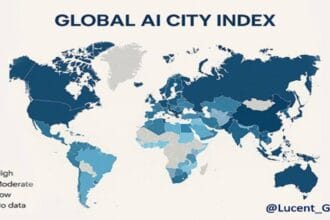
In a landmark move to transform the accuracy and speed of weather forecasting, the Ministry of Earth Sciences (MoES) has launched two new high-performance computing systems ARKA and ARUNIKA supercomputers. These cutting edge supercomputers are poised to revolutionize weather and climate prediction in India, offering significantly improved models, early warnings, and disaster response capabilities.
- What Are ARKA and ARUNIKA?
- Why the Upgrade Matters
- Empowering Citizens and Sectors Alike
- High Resolution Forecasts: A Game Changer
- Strategic Implementation and Data Handling
- 1. Indian Institute of Tropical Meteorology (IITM), Pune
- 2. National Centre for Medium Range Weather Forecasting (NCMRWF), Noida
- 3. Dedicated AI/ML System
- Enhancing Early Warning Systems with AI and ML
- Conclusion
With a combined computing power of 22 PetaFLOPS, the ARKA and ARUNIKA supercomputers represent a monumental leap from the previous capacity of 6.8 PetaFLOPS. This enhanced infrastructure will not only elevate India’s meteorological capabilities but also empower various sectors including agriculture, water resources, energy, and disaster management.
What Are ARKA and ARUNIKA?
ARKA and ARUNIKA are the latest high-performance supercomputers developed by the Ministry of Earth Sciences to support India’s growing needs in climate modeling, weather prediction, and AI-based forecasting tools.
These systems are strategically hosted at three major scientific centers:
- IITM Pune: Houses 11.77 PetaFLOPS with 33 petabytes of storage
- NCMRWF Noida: Hosts 8.24 PetaFLOPS with 24 petabytes of storage
- Dedicated AI and ML node: Offers an additional 1.9 PetaFLOPS for machine learning based forecasting systems
These supercomputers are built to support high resolution forecasts on a 1 km grid scale, ensuring far more granular and location specific predictions for Indian regions.
Why the Upgrade Matters
The launch of ARKA and ARUNIKA supercomputers marks a “New Dawn in Weather Prediction.” Weather extremes, such as cyclones, droughts, and heatwaves, are increasing in frequency and intensity due to climate change. Accurate, timely, and localized forecasting is not just a scientific need but a socio-economic necessity.
Key areas where ARKA and ARUNIKA supercomputers will make a difference include:
- Cyclones and Heavy Rainfall: Enhanced modeling capabilities will provide more precise cyclone path predictions and rainfall intensity.
- Thunderstorms and Hailstorms: Faster simulations will improve short term warnings for severe storms.
- Heat Waves and Droughts: Longer term climate modeling will aid in better planning and mitigation strategies.
- Advanced AI/ML Integration: The dedicated AI & ML system will support machine learning models for improved accuracy and reduced false positives in early warnings.
With these upgrades, India aims to become a global leader in climate and weather forecasting systems.
Empowering Citizens and Sectors Alike
The ARKA and ARUNIKA supercomputers are designed to benefit a wide spectrum of users:
- Farmers: More accurate forecasts mean better agricultural planning, reducing crop loss.
- Disaster Managers: Real time insights allow quicker evacuations and efficient resource deployment.
- Policymakers: Improved data enables smarter planning in urban development, water management, and energy supply.
- Citizens: Timely alerts on extreme weather ensure safety and preparedness.
This initiative aligns with India’s goal of climate resilience and digital governance, ensuring science reaches the last mile.
High Resolution Forecasts: A Game Changer
One of the most significant benefits of the ARKA and ARUNIKA supercomputers is their ability to process high resolution weather models. These systems will enable:
- Forecasting on a 1 km x 1 km grid scale, compared to the previous 12 km scale.
- Real time analysis of satellite, radar, and ground observation data.
- Integration with global climate models for more robust long term predictions.
This increased resolution allows hyperlocal predictions that are crucial for disaster prone regions, urban centers, and farming communities.
Strategic Implementation and Data Handling
The supercomputers have been strategically installed in:
1. Indian Institute of Tropical Meteorology (IITM), Pune
- Processing Power: 11.77 PetaFLOPS
- Storage: 33 Petabytes
2. National Centre for Medium Range Weather Forecasting (NCMRWF), Noida
- Processing Power: 8.24 PetaFLOPS
- Storage: 24 Petabytes
3. Dedicated AI/ML System
- Processing Power: 1.9 PetaFLOPS
Together, the ARKA and ARUNIKA supercomputers form the backbone of India’s next generation climate information system.
Enhancing Early Warning Systems with AI and ML
With artificial intelligence becoming central to modern forecasting systems, India’s new supercomputers will harness AI and machine learning to:
- Analyze large datasets in real time
- Detect weather anomalies faster
- Reduce prediction errors and improve warning accuracy
- Automate communication of alerts to relevant authorities and citizens
These capabilities are particularly crucial during events like monsoon depressions, flash floods, or unseasonal heatwaves, where minutes can save lives.
Conclusion
India’s unveiling of ARKA and ARUNIKA supercomputers represents a watershed moment in its journey toward advanced climate resilience and weather intelligence. With cutting edge technology, enhanced grid scale precision, and powerful AI driven models, the country is well on its way to becoming a global powerhouse in weather forecasting and environmental planning.
These systems will not only help the nation tackle immediate meteorological challenges but also build a data driven future for disaster risk reduction, sustainable agriculture, and climate adaptation.
Stay Connected with The News Drill for more updates on scientific breakthroughs and climate technology. Stay informed. Stay updated. Stay Ahead.
Contact us: contact@thenewsdrill.com
Submit tips or story: editor@thenewsdrill.com
The News Drill remains committed to bringing you high quality, science backed, and timely news for a better informed and climate resilient society.







